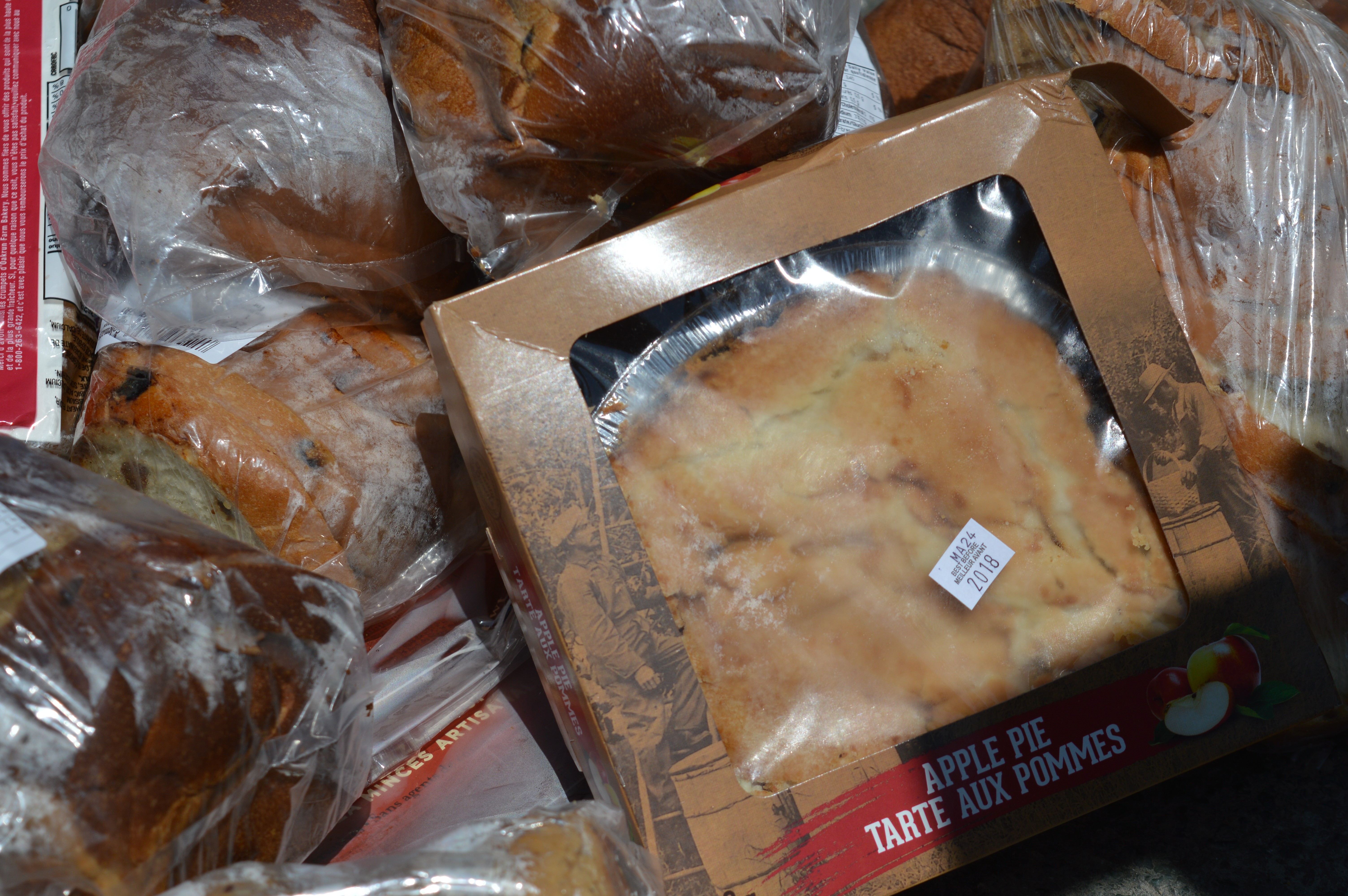Serving up waste
Arthur Craig Green
Share Article
Retailers and restaurants account for almost 20 per cent of all food wasted in Canada. As part of a major upcoming series, Kicker reporter Arthur C. Green delved into dumpsters and dinner plates to get to the bottom of the problem. Here's a taste of Waste Age.
Everyone is guilty of it - purging your refrigerator of almost-expired items to make room for new grocery purchases.
But how much food is wasted behind the doors at your grocery store or your local restaurant?
Many Canadians take almost-expired items for granted while less fortunate people in this country and in other parts of the world go hungry.
Grocery stores in Canada often throw food into the trash before its best-before date.
Such waste was evident at two unlocked dumpsters behind Colemans grocery locations in St. John’s and Mount Pearl on May 15.
The sweet smell of fresh molasses raisin bread and other food items emerged from the garbage.
One clear garbage bag in the pile held non-expired items with price stickers adding up to $52.76 - enough to fill a small shopping cart.
One of the bags had items such as apple pies with an expiry date of May 24, 2018.
That means they were thrown out nine days before the expiry date Other items such as bagels, trifles and muffins had expiry dates that were four days away. The items were unspoiled and tasted fresh.
Kicker investigated all major grocery retailers within St. John’s for food wastage - including Costco, Dominion, Sobeys and Colemans.
Most of their dumpsters were locked, while other stores used compactors from Newfound Disposal Systems Limited.
These measures made it impossible to see the contents inside.
While Kicker found wasted items only at Colemans, a CBC investigation in 2016 uncovered food waste at a Walmart in Ontario.
According to a 2014 Value Chain Management Study, about 10 per cent of food wasted in Canada happens at the retail level, about nine per cent at restaurants and hotels, and a whopping 47 per cent at the consumer level.
If we are not 100 per cent confident, we do not offer the product for sale
—Jeff Wells, Colemans.
Jeff Wells, the director of operations with the Coleman Group of Companies, says Colemans' main concerns are food safety and quality.
“Sometimes a really good-looking product can be disposed of early because of a food safety concern,” said Wells.
Concerns can include cross-contamination with other products and temperature issues, said Wells.
He also said the aesthetics of the product can be a factor. For example, if tomatoes start to go mushy, they might be thrown out.
Colemans produce managers will inspect items daily. If they see something they would not use in their own homes, they throw it out.
“If we are not 100 per cent confident, we do not offer the product for sale,” said Wells.
However, Wells says food wastage is a huge environmental concern to the Colemans chain, and the company is implementing programs to combat this problem, which was a topic discussed at a recent managers meeting in St. John’s.
“Location by location, we offer culled products to employees for composting,” Wells said. “We also measure product waste to determine product ordering to reduce wastage.”
Retailers can do more, says expert
The amount of food wasted in Canada each year by retail and restaurants amounts to about $589 million – roughly 19 per cent of the $31 billion wasted every year.
Some grocery chains such as Loblaw’s, the parent company of Dominion, have introduced special lines of less-than-perfect produce.
In Dominion’s case, its Naturally Imperfect line includes “ugly” produce such as misshapen peppers or cracked carrots.
However, not every grocery chain would want to classify its food in different categories, suggests food distribution, security and safety expert Sylvain Charlebois.
Some chains would not want to create different tiers of food quality as consumers would choose the cheapest option available, said Charlebois, a professor at Dalhousie University in Halifax.
Another factor in food wastage at the grocery store is what’s known as the cold chain: a temperature-controlled supply chain that moves from production through shipment and storage go the store itself.
Cold chains prevent bacteria outbreaks from happening by keeping the temperature of food at 3C throughout the chain of distribution.
Sometimes, though, refrigeration systems break and temperatures go up.
Therefore, retail grocery stores face many challenges when it comes to food wastage, said Charlebois.
“Cold chain breaches are very common,” Charlebois said. “Retailers don’t want to take the risks.”
Charlebois added that some stores might not have a proper supply chain design or may have limited options.
“The garbage is an easy way out for most businesses, and often they don’t see the opportunity, or even worse, costs associated with throwing away food.”
However, Charlebois offers some advice to grocery retailers in ways they can reduce their waste to keep non-expired items out of the trash.
“They should talk to their suppliers and get better coordinated with food security agencies,” Charlebois said. “Many do it already, but consumers are starting to realize that food products can be repurposed and used differently.”
For example, businesses can use almost-expired bread into bread crumbs and freeze them.
Being creative is always key.
Retailers can offer rebates to those consumers wanting to get deals on almost expired items, thus reducing waste.
From the dumpster to his freezer
Patrick O’Brien is from St. John’s and is poor. He lives on an extremely small budget and tries to stretch every cent he gets.
There are days when O’Brien’s stomach stays empty because he cannot afford to eat every day.
O’Brien was shocked by the food thrown out at the Colemans locations.
“People are hungry in my neighbourhood, and no store should be throwing out good food.”
— Patrick O’Brien
“It’s a goddamn shame,” O’Brien said. “People are hungry in my neighborhood, and no store should be throwing out good food.”
O’Brien accepted the perfectly packaged apple pies, tea buns and two shopping bags of molasses bread removed from the Colemans dumpster on Merrymeeting Road.
O’Brien immediately placed the items in his rugged 30-year-old deep freeze for future use
“I can’t believe the items that were thrown out,” O’Brien said. “Food banks are always looking for donations while Colemans are chucking it out in the garbage? It sickens me.”
O’Brien purchases around 52 loaves of bread a year at various prices from different stores.
“If I could go to a dumpster every second day and collect fresh items like this on a consistent basis, I would have enough to feed the neighborhood,” O’Brien said. “I’d be king of the hood.”
We don’t condone people eating products out of our dumpsters.
—Jeff Wells, Colemans
Colemans does donate to local food banks through its Food for Friends program.
It is also creating a new program to sell almost-expired food at discounted prices.
“Colemans will have a new section where we will sell all our distressed products,” Wells said. “This will be implemented at our Stephenville location.”
Wells suggested the apple pies and other products could have been thrown into the Colemans dumpster because of safety concerns.
“It could have been a handling or some type of quality issue,” Wells said. “There could have been an issue with temperature control or the way the products were stored.”
O’Brien ate the products from the dumpster, and he did not end up sick. However, Colemans does not condone anyone removing any non-expired items from their garbage.
“This is a pretty dangerous thing to do,” Wells said. “It’s disturbing.”
Something happened to the products for them to end up in the waste pile at Colemans, Wells says.
He is now considering locking the dumpsters in the future from a food safety point of view.
“We don’t condone people eating products out of our dumpsters,” Wells said.
Sobeys, Costco and Dominion declined comment.
According to RethinkWasteNL, which is run by the Multi-Materials Stewardship Board here in the province, Canadians waste $31 billion worth of food every year – enough to purchase more than 200 747 jumbo jets.
Restaurants aim to reduce waste
The average restaurant produces 150,000 pounds of garbage each year – the equivalent of 40 cars – according to the Green Restaurant Association.
Most of that garbage ends up in landfills.
However, it’s not in the economic interests of restaurants to waste food.
“Each individual restaurant business, especially in tough economic times would try not to have food wastage,” said Nancy Brace, executive director of the Restaurant Association of Newfoundland and Labrador.
“A lot of the food wasted by restaurants would be because of the poor quality of food received.”
Geography plays a role.
When restaurants located in California accept delivery of lettuce, the product would have left the farm only two days earlier. Before reaching this province, the lettuce would have to travel several days, maybe even a week, Brace says.
“By the time the wholesaler gets it and brings it to the restaurant, the businesses are looking at a substantial amount of time.” Brace said. “The outside of the lettuce would start to deteriorate, and maybe three layers is nothing but wastage.”
The weather in this province is also a huge factor when managing the demand and wastage of food for restaurants, according to food expert Sylvain Charlebois.
“Restaurants are always one storm away from wasting a lot of food,” Charlebois said.
According to the Sustainable Restaurant Association, 65 per cent of food wasted at restaurants is prep waste, 30 per cent is plate waste (what diners leave on their plates) and five per cent is spoilage.
If food is usable, suggests Brace, most restaurants will incorporate it into their menus.
For example, if a restaurant prepares chicken dinners for a party of 50 guests and only 30 guests show up, the restaurant manager would have a plan in place to use the leftover food in a special the next day as a soup or pasta.
This is a common practice in many restaurants in St. John’s, Brace said.
Charlebois says menu design is also a significant factor for restaurants reducing food waste.
“Portion sizes are also another challenge as well,” Charlebois said. “They need to be focused on procurement strategies and demand management.”
Restaurants receive income only from the food they sell, which covers their operating costs. The items on the menu, therefore, are the businesses’ only revenue stream, Brace says.
Some tactics for reducing food wastage at restaurants would be to eliminate the practice of serving complimentary bread to customers, making them buy the bread or limiting the bread to one slice per person.
“Restaurants will have to get real creative when it comes to food wastage to avoid menu price increases,” said Brace, “because that’s throwing money out the backdoor.”
Kicker and Rogers TV will broadcast a live forum about food wastage 7 - 8:30 p.m. on Wednesday, June 13. Drop by to join in the conversation or watch us on Rogers TV.





Be the first to comment